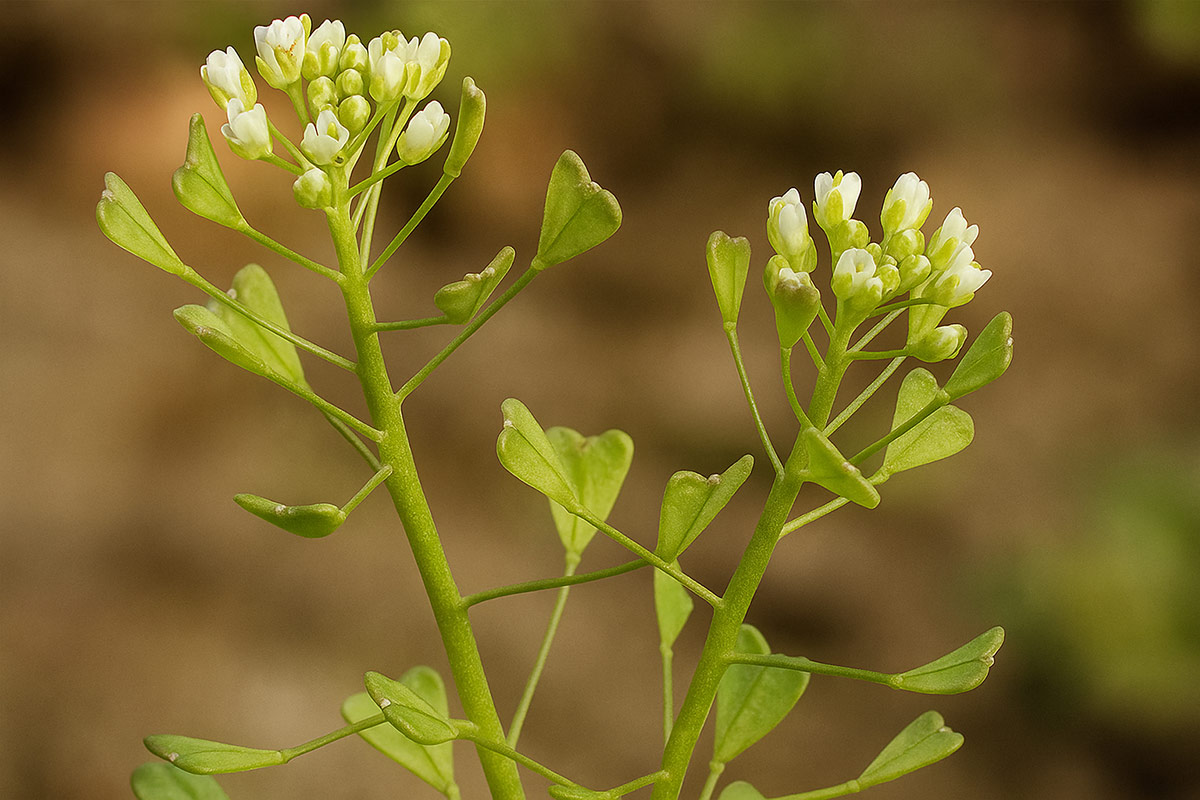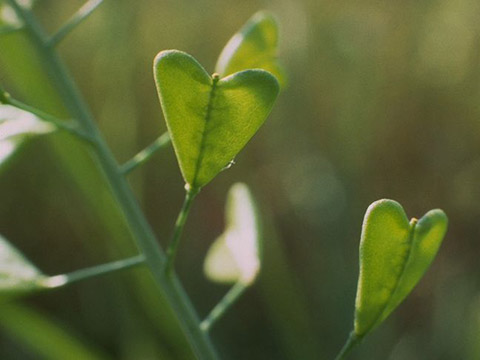Botanical name
Capsella bursa-pastoris (L.) Medik.
Family
Brassicaceae
Common name
Shepherd's Purse, Mother’s Heart, Case Weed, Poor Man’s Parmacetty
Information about the plant
The common shepherd's purse is a cosmopolitan plant and, as such, is widespread across temperate and mountainous tropical regions worldwide. It reproduces mainly through self-pollination and, therefore, does not depend on bee pollination, making its population particularly robust. The plant grows on nutrient-rich soils, especially in gardens and fields as a weed, and in ruderal vegetation such as rubble sites and earthen embankments.
The name of the plant was already used before Linné, and it is characterized by its striking, inverted, heart-shaped fruits (botanical name: siliques). They resemble the fur capes worn by shepherds in the Middle Ages. Capsella is the diminutive of the Latin “capsa” (= capsule), bursa comes from Latin “bursa” (= fur), and pastoris is the genitive form of “pastor” (= shepherd). This was combined into the name shepherd's purse.
Shepherd's purse is an annual herb that grows up to 80 cm tall. The stem – usually single, sometimes branched – grows from a basal rosette of leaves with entire margins. The few stem leaves are sessile, lanceolate, and broadly auriculate, clasping the stem. The small, white, cruciform flowers have long stalks. After fertilization, the plant develops its characteristic inverted, heart-shaped, triangular siliques (shepherd's purses). Since there are varieties that germinate in both spring and fall, flowering plants can be found from January to October.
Medicinally used parts of plants (herbal drug)
The dried aerial parts collected during flowering are used, consisting of leaves, flowers, stems, and fruits (shepherd's purse herb - Bursae pastoris herba).
The commercially available drug is obtained from wild collections in Eastern European countries.
Constituents of the herbal drug
Shepherd's purse contains flavonoids, biogenic amines, amino acids, and proteins.
Quality of the drug
The quality of shepherd's purse (Bursae pastoris herba) is specified in the European Pharmacopoeia (Ph. Eur.).
Medical applications
Recognised medical use
The HMPC has classified shepherd's purse as a traditional herbal medicinal product (see ‘Traditional use’).
ESCOP: Shepherd's purse has not been evaluated.
Traditional use
The HMPC has classified shepherd's purse as a traditional herbal medicinal product (Article 16a of Directive 2001/83/EC). Based upon long-standing use, shepherd's purse can be used to treat heavy menstrual bleeding in women with a normal menstrual cycle, provided that a serious medical condition has been ruled out by a doctor.
Herbal drug preparations in finished dosage forms
- Cut shepherd's purse for tea preparation
- Dry extracts in coated tablets and tablets
- Fluid extract in liquid preparations
- Alcoholic extracts in drops
Dosage
Finished medicinal product: See patient information leaflet.
Tea: Internal use: Drink one cup of warm shepherd's purse tea 2 to 4 times daily, 3 to 5 days before and during menstruation. Daily dose: 3 to 20 g of the drug.
Lukewarm tea is used for compresses or as a nasal tamponade.
Preparation of a tea
For internal use: Pour approximately 150 mL of boiling water over 3 to 5 g of finely chopped shepherd's purse and strain after 10 to 15 minutes.
For external use as a hemostatic agent: Pour 100 mL of boiling water over 10 g of the drug and strain after 15 minutes.
Notes
No studies have been published on the safety of shepherd's purse during pregnancy and lactation. The use in children and adolescents under 18 years of age is not recommended due to a lack of evidence.
Side effects
None known.
Interactions
None known.
References
Herbal drug monographs
HMPC (2011, 2019).
Further literature
Commentary on the European Pharmacopoeia (Shepherd's purse, No. 2947 – in progress).



